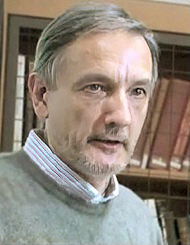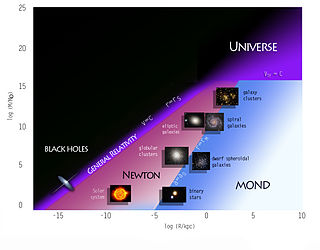
General relativity, also known as the general theory of relativity and Einstein's theory of gravity, is the geometric theory of gravitation published by Albert Einstein in 1915 and is the current description of gravitation in modern physics. General relativity generalizes special relativity and refines Newton's law of universal gravitation, providing a unified description of gravity as a geometric property of space and time or four-dimensional spacetime. In particular, the curvature of spacetime is directly related to the energy and momentum of whatever matter and radiation are present. The relation is specified by the Einstein field equations, a system of second order partial differential equations.
Quantum gravity (QG) is a field of theoretical physics that seeks to describe gravity according to the principles of quantum mechanics. It deals with environments in which neither gravitational nor quantum effects can be ignored, such as in the vicinity of black holes or similar compact astrophysical objects, such as neutron stars.
In theoretical physics, the Einstein–Cartan theory, also known as the Einstein–Cartan–Sciama–Kibble theory, is a classical theory of gravitation similar to general relativity. The theory was first proposed by Élie Cartan in 1922. Einstein–Cartan theory is the simplest Poincaré gauge theory.
Teleparallelism, was an attempt by Albert Einstein to base a unified theory of electromagnetism and gravity on the mathematical structure of distant parallelism, also referred to as absolute or teleparallelism. In this theory, a spacetime is characterized by a curvature-free linear connection in conjunction with a metric tensor field, both defined in terms of a dynamical tetrad field.

Brandon Carter, is an Australian theoretical physicist, best known for his work on the properties of black holes and for being the first to name and employ the anthropic principle in its contemporary form. He is a researcher at the Meudon campus of the Laboratoire Univers et Théories, part of the CNRS.
In differential geometry and theoretical physics, the Petrov classification describes the possible algebraic symmetries of the Weyl tensor at each event in a Lorentzian manifold.
The Lanczos tensor or Lanczos potential is a rank 3 tensor in general relativity that generates the Weyl tensor. It was first introduced by Cornelius Lanczos in 1949. The theoretical importance of the Lanczos tensor is that it serves as the gauge field for the gravitational field in the same way that, by analogy, the electromagnetic four-potential generates the electromagnetic field.
The Cartan–Karlhede algorithm is a procedure for completely classifying and comparing Riemannian manifolds. Given two Riemannian manifolds of the same dimension, it is not always obvious whether they are locally isometric. Élie Cartan, using his exterior calculus with his method of moving frames, showed that it is always possible to compare the manifolds. Carl Brans developed the method further, and the first practical implementation was presented by Anders Karlhede in 1980.
SHEEP is one of the earliest interactive symbolic computation systems. It is specialized for computations with tensors, and was designed for the needs of researchers working with general relativity and other theories involving extensive tensor calculus computations.

Jürgen Ehlers was a German physicist who contributed to the understanding of Albert Einstein's theory of general relativity. From graduate and postgraduate work in Pascual Jordan's relativity research group at Hamburg University, he held various posts as a lecturer and, later, as a professor before joining the Max Planck Institute for Astrophysics in Munich as a director. In 1995, he became the founding director of the newly created Max Planck Institute for Gravitational Physics in Potsdam, Germany.
Tevian Dray is an American mathematician who has worked in general relativity, mathematical physics, geometry, and both science and mathematics education. He was elected a Fellow of the American Physical Society in 2010.

Laurent Nottale is an astrophysicist, a retired director of research at CNRS, and a researcher at the Paris Observatory. He is the author and inventor of the theory of scale relativity, which aims to unify quantum physics and relativity theory.
The zero-energy universe hypothesis proposes that the total amount of energy in the universe is exactly zero: its amount of positive energy in the form of matter is exactly canceled out by its negative energy in the form of gravity. Some physicists, such as Lawrence Krauss, Stephen Hawking or Alexander Vilenkin, call or called this state "a universe from nothingness", although the zero-energy universe model requires both a matter field with positive energy and a gravitational field with negative energy to exist. The hypothesis is broadly discussed in popular sources. Other cancellation examples include the expected symmetric prevalence of right- and left-handed angular momenta of objects, the observed flatness of the universe, the equal prevalence of positive and negative charges, opposing particle spin in quantum mechanics, as well as the crests and troughs of electromagnetic waves, among other possible examples in nature.
Edward Fomalont is an American scientist working at the National Radio Astronomy Observatory. He specializes in radio galaxies, X-ray binary systems, astrometry, and general relativity. He has published more than 330 papers in peer-reviewed journals and proceedings of scientific conferences.
In physics, relativistic chaos is the application of chaos theory to dynamical systems described primarily by general relativity, and also special relativity and also by Newton's law of segments and motion.

Extended theories of gravity are alternative theories of gravity developed from the exact starting points investigated first by Albert Einstein and Hilbert. These are theories describing gravity, which are metric theory, "a linear connection" or related affine theories, or metric-affine gravitation theory. Rather than trying to discover correct calculations for the matter side of the Einstein field equations; which include inflation, dark energy, dark matter, large-scale structure, and possibly quantum gravity; it is proposed, instead, to change the gravitational side of the equation.
In physics, specifically general relativity, the Mathisson–Papapetrou–Dixon equations describe the motion of a massive spinning body moving in a gravitational field. Other equations with similar names and mathematical forms are the Mathisson–Papapetrou equations and Papapetrou–Dixon equations. All three sets of equations describe the same physics.
Achille Papapetrou was a Greek theoretical physicist, who contributed to the general theory of relativity. He is known for the Mathisson–Papapetrou–Dixon equations, the Majumdar–Papapetrou solution, and the Weyl−Lewis−Papapetrou coordinates of gravity theory.
The Hayward metric is the simplest description of a black hole which is non-singular. The metric was written down by Sean Hayward as the minimal model which is regular, static, spherically symmetric and asymptotically flat. The metric is not derived from any particular alternative theory of gravity, but provides a framework to test the formation and evaporation of non-singular black holes both within general relativity and beyond. Hayward first published his metric in 2005 and numerous papers have studied it since.

Dharam Vir Ahluwalia is an Indian-born American theoretical physicist who has made significant contributions to physics of neutrino oscillations, gravitationally induced phases, interface of the gravitational and quantum realms, and mass dimension one fermions. In 2019 he published Mass Dimension One Fermions.





